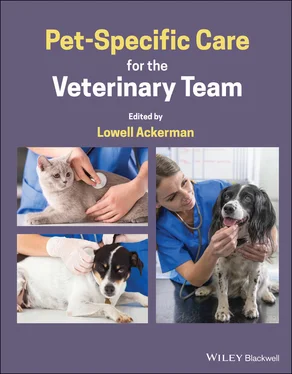Highly attached owners may struggle with their grief after the death of a pet. This can be very taxing for clinic staff. Referral to a professional pet grief counselor can help these owners.
Clients’ previous experience of loss can affect their approach to veterinary care for their current pets. Some owners who have cared for, treated, and nursed a chronically and seriously ill pet may decline treatment for other pets due to their perceptions of the emotional cost to themselves and the quality of life for the now deceased pet.
Staff training about the HAB can make each staff member aware of their own feelings and attitudes about animals and how this may affect their interactions with clients.
 EXAMPLES
EXAMPLES
Sunnyside Veterinary Clinic educated all staff about the HAB. All staff were able to assess their attachment levels and compare them against the range and styles of HAB in literature. Understanding the different ways in which people can express their bond with their pets helped staff respond to client concerns appropriately and accept client decisions about treatment for their pets. Staff morale improved, with many reporting they felt less frustration with clients.
 TAKE‐AWAYS
TAKE‐AWAYS
The HAB has benefits for owners and pets and for communities when it is strong and supported.
The HAB is fragile and easily broken. It is very susceptible to damage from unmet expectations of the animal and problem behaviors.
As a clinic, celebrate the HAB in ways that are authentic. Genuine interest in patient well‐being and helping owners with their pets is more effective than marketing gimmicks.
All staff must be aware of how different people express the bond they have with their pet. Accepting the range of attachment by owners helps staff accept owner decisions for their pet.
Use other professionals to help highly attached owners cope with the loss of a pet. Some will need professional help to recover from the loss of their pet.
 MISCELLANEOUS
MISCELLANEOUS
2.14.3 Cautions
Compassion fatigue can come about in veterinary clinics when staff are dealing with highly attached pet owners who need extra attention to help them cope with sick, dying or recently deceased pets (see 8.17Dealing with Compassion Fatigue).
Compassion fatigue can also occur when staff are interacting with clients whose attachment levels are very different from their own beliefs and attitudes about the HAB. Education of staff about the HAB and how it varies with different people can help staff accept owner decisions and minimize staff stress.
As companion animals are more highly valued, negative treatment outcomes may be less tolerated by some owners, leading to litigation. Care should be taken to cover the risks associated with treatments in writing and have the owner sign the form in all cases. Adequate professional insurance is also a necessity.
1 1 Brockman, B.K., Taylor, V.A., and Brockman, C.M. (2008). The price of unconditional love: consumer decision making for high‐dollar veterinary care. Journal of Business Research 61 (5): 397–405.
2 2 DiGiacomo, N., Arluke, A., and Patronek, G.J. (1998). Surrendering pets to shelters: the relinquisher's perspective. Anthrozoos 11 (1): 41–51.
1 Blazina, C., Boya, G., and Shen‐Miller, D. (2011). The Psychology of the Human–Animal Bond: A Resource for Clinicians and Researchers. New York: Springer.
2 Daley, O.M. (2009). Made for each Other: The Biology of the Human–Animal Bond. Cambridge: Merloyd Lawrence Paperbacks.
3 Human Animal Bond Research Institute: https://habri.org/
4 The Compassion Fatigue Project. www.compassionfatigue.org/index.html
2.15 Promoting the Human–Animal Bond
Sarah Rumple
Rumpus Writing and Editing LLC, Denver, CO, USA
 BASICS
BASICS
2.15.1 Summary
Veterinary professionals should play an active role in promoting the human–animal bond among their clients. At the heart of that effort is client education, with a focus on preventive healthcare and behavior. Education should be taken beyond the typical exam room discussions to include alternative methods that are easily absorbed by pet owners.
When clients understand how to keep their pets healthy and how to properly address potential behavior concerns, fewer pets will be relinquished and euthanized, the human–animal bond will continue to grow, and veterinary practices will flourish.
Human–Animal Bond:A mutually beneficial and dynamic relationship between people and animals that is influenced by behaviors essential to the health and well‐being of both.
 MAIN CONCEPTS
MAIN CONCEPTS
2.15.3 The Human–Animal Bond
The human–animal bond is a mutually beneficial relationship between people and animals (see 2.14Benefits of the Human–Animal Bond). According to the American Veterinary Medical Association (AVMA), the veterinarian's role in the human–animal bond is to maximize the potentials of the relationship between people and animals [1].
How can veterinarians maximize the potentials of the relationship between people and animals? Education is key. While pet owners usually have the best intentions, many do not understand how to provide the best care for their pets so they can enjoy longer, healthier, happier lives together. When veterinary practitioners adequately educate pet owners on how to provide exceptional care for their pets – and why they should provide this care – they are promoting the human–animal bond, which enhances the health and well‐being of pets and their owners.
2.15.4 Client Education Opportunities
In addition to traditional exam room conversations, consider these opportunities to educate your clients.
Enhanced exam room communication: while it's true that much of what veterinary professionals say to pet owners in the exam room is misheard, misunderstood, or later forgotten, there are resources available to aid in your exam room client education efforts (see 5.10Discussing Pet‐Specific Care). Bring visual aids to support your messaging (images of heartworms or periodontal disease will have a bigger impact on clients than your explanation of these conditions alone). Provide printouts with images, your recommendations, and more applicable information for clients to take home and read later.
Custom literature: invest in brochures and other literature customized to your practice on a variety of pet health and behavior topics. While digital communication and online resources are important, many clients appreciate a tangible resource they can take home.
Читать дальше

 EXAMPLES
EXAMPLES TAKE‐AWAYS
TAKE‐AWAYS MISCELLANEOUS
MISCELLANEOUS BASICS
BASICS MAIN CONCEPTS
MAIN CONCEPTS










